The world of electric guitars is filled with many fascinating questions, but one that often sparks debate among musicians and enthusiasts alike is: Do electric guitars sound better with age?
In this article, we’ll delve into this intriguing topic, exploring the aging process of electric guitars and how it potentially affects their sound.
You can use the table of contents below to take you to the area that interests you. Click on the little box to open it and then click on the section of the article you want to read, or you can read from start to finish if you want the full guitar aging experience!
The Short Answer
While there’s no definitive “yes” or “no” answer to whether electric guitars sound better with age, many factors can influence the sound over time. These include the quality of the materials used, how well the guitar is maintained, and even the player’s skill and technique. Electronic components can also change the sound of the guitar as they age.
Keep On Reading (Below) To Learn More
How Electric Guitars Age
Understanding the aging process of electric guitars requires a look at the materials and components that make up these instruments. The body and neck of an electric guitar, usually made of wood, can undergo changes over time. Wood is a natural material that reacts to environmental conditions, and over the years, it can dry out, warp, or even crack, affecting the guitar’s resonance and, consequently, its sound.
However, unlike acoustic guitars, the sound of electric guitars is not primarily produced by the resonance of the wood body. Instead, it’s the electronic components – the pickups, that play a crucial role in shaping the sound. These components can also change over time, affecting the guitar’s tone.
How Aging Changes The Sound Of Guitar Pickups
Electric guitar pickups are essentially magnets that capture the strings’ vibration and convert it into an electrical signal, which is then amplified. Over time, these magnets can demagnetize, and the wire coils around them can degrade. This can result in a change in the guitar’s output, potentially leading to a warmer, mellower tone.
However, whether this is perceived as ‘better’ can be highly subjective and depends largely on individual preferences. If you’re a jazz player, you’ll probably like an aged pickup sound, but if you play metal, the weakened and less aggressive signal output probably won’t cut it.
Taking A Closer Look
This table summarizes the effect on a guitar’s sound and playability as various parts age.
| Guitar Part | How it Ages | Effect on Sound | Effect on Playability |
|---|---|---|---|
| Wood (Body and Neck) | Can dry out, warp, or crack over time | Can affect the guitar’s resonance, potentially changing the tone | Warping or cracking can affect the guitar’s action and intonation, making it harder to play |
| Pickups | Magnets can demagnetize, wire coils can degrade | Can decrease the guitar’s output, potentially leading to a warmer, mellower tone | No direct effect on playability, but can change the player’s experience of the sound |
| Strings | Can rust or break | Old strings can sound dull or flat | Old or broken strings can make the guitar harder to play and can cause tuning instability |
| Frets | Can wear down over time | Worn frets can cause buzzing or dead notes | Worn frets can make the guitar harder to play and can cause intonation problems |
| Hardware (Tuning pegs, bridge, etc.) | Can rust or become loose | No direct effect on sound, but loose hardware can cause tuning instability | Rusty or loose hardware can make the guitar harder to tune and play |
Still, Opinions Can Vary
The question of whether electric guitars sound better with age has been the subject of various studies and expert opinions. Some experts argue that the aging process can lead to a more refined sound, as the wood’s natural resins crystallize over time, leading to better resonance.
However, others point out that the electronic components’ aging, such as the pickups and wiring, can have a more significant impact on the sound.
So, some firmly believe in the positive impact of aging on the sound of an electric guitar, while others remain skeptical.
How About Laminate Electric Guitars?
Laminate electric guitars are made of two or more layers of wood that are glued together. They are not necessarily cheaper than solid wood guitars. However, depending on their construction, they can age differently than their solid wood counterparts.
Expensive Versus Less Expensive Guitars
Laminated electric guitars come in two basic construction qualities, expensive (more costly) and less expensive (cheaper). I don’t want to call anyone’s guitar “cheap,” so let’s use the terms well-made and less well-made instead.
Well-Made Laminate Electric Guitars
Not all laminated electric guitars are poorly constructed. Well-made laminate electric guitars can age very similarly to solid-wood electrics.
There are some high-quality laminated guitars on the market, such as some Fender Squier guitars, the Epiphone Les Paul, and the Paul Reed Smith SE Custom 24 guitar pictured below.
All PRS SE guitars have a laminated veneer on a maple cap.
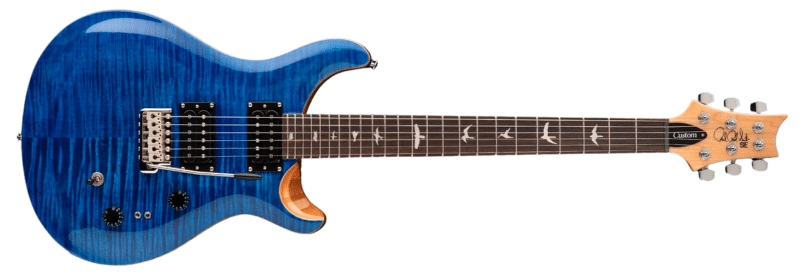
Less Well-Made Laminate Guitars
First off, you should know that laminated wood bodies are not common in less well-made electric guitars.
They are typically found in less well-made acoustic guitars, where it’s used as a cost-saving measure. Many of these guitars are constructed from laminated agathis, and they can age differently from well-made guitars. Agathis wood is a soft, lightweight wood that is native to Indonesia.
General Characteristics Of Laminate Electric Guitars.
Durability
Laminate woods are typically more resistant to changes in humidity and temperature, which means they’re less likely to warp or crack over time compared to solid wood guitars. This can make laminate guitars more durable in the long run, especially in fluctuating environmental conditions.
Tone
The aging process can affect the tone of solid wood guitars, often leading to a richer, more resonant sound as the wood matures. However, less well-built laminate guitars don’t experience the same tonal evolution. Their tone is largely static and won’t change significantly over time.
Finish And Appearance
Like solid wood guitars, the finish on a laminate guitar can show signs of aging, such as checking or fading, especially with exposure to sunlight and temperature fluctuations. However, because laminate is less prone to warping, you may see fewer structural changes like bowing or twisting in the neck or body.
Hardware And Components
The aging of a laminate guitar’s hardware and electronic components would be similar to that of a solid wood guitar. Over time, parts like the tuning machines, pickups, and potentiometers can wear out or degrade, which can affect the guitar’s playability and sound.
So, in summary, while laminate electric guitars may not experience the same tonal evolution as solid wood guitars, they can still show signs of aging in their finish and hardware. However, their resistance to environmental changes can make them a more stable choice over time.
Caring For Your Electric Guitar As It Ages

Regardless of whether age improves the sound of an electric guitar, one thing is certain: proper care and maintenance can significantly extend your instrument’s lifespan and keep it sounding its best.
Regular cleaning, proper storage, and occasional servicing by a professional can help prevent damage and wear that could negatively impact your guitar’s sound.
Maintenance Tips for Preserving Sound Quality
Tips for preserving sound quality include regular string changes, keeping the guitar clean and dust-free, and ensuring it’s stored in a stable, humidity-controlled environment.
If the guitar will not be played for a while, it’s a good idea to loosen the strings by tuning it down ½ to 1 step before storing it away.
Importance of Regular Servicing
Just like a car, your electric guitar needs regular servicing to ensure it continues to perform at its best. This includes tasks like adjusting the truss rod to maintain the correct neck relief, setting the action to ensure the strings are at the optimal height, and checking the intonation so that the guitar stays in tune up and down the neck.
Regular servicing can also catch potential issues before they become major problems, such as loose wiring or hardware, worn frets, or issues with the guitar’s electronics.
Accelerating The Aging Process
The aging process of an electric guitar can be natural or artificial.
Both processes can change the sound of an electric guitar, although the natural aging process typically produces the most sought-after tone improvements.
Natural Aging Factors
This is due to an electric guitar’s natural aging and “wear and tear.” This process occurs even if a new guitar is purchased and never played. Naturally aged (vintage) guitars command a high price tag due to the tonal improvements that can occur over time.
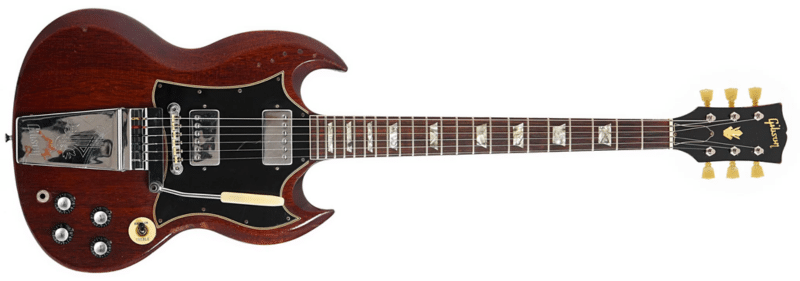
Here are some of the things that can naturally age a guitar.
Playing The Guitar
Regularly playing the guitar can speed up the aging process. The oils and sweat from your hands can wear down the finish on the neck, and the pick can cause scratches and dings on the body. Over time, this can give the guitar a worn, aged look.
Environmental Conditions
Exposure to varying temperatures and humidity levels can also age a guitar. Wood expands and contracts with changes in temperature and humidity, which can lead to the finish checking or cracking.
Sunlight
Exposure to sunlight can cause the color of the guitar’s finish to fade over time, giving it an aged appearance.
Artificial Aging Techniques (“Relicing”)
Artificial aging, also known as “relicing,” is a process where a guitar is intentionally distressed to give it the appearance of an older, well-played instrument.
Relicing is more about giving the guitar a specific look and playability, but things like dying out the tonewoods and aging the pickups can also improve its tone.
Guitar custom shops offer reliced guitars, but some players relic their own instrument by distressing it and buying “aged” parts. The custom shop models usually look, play, and sound better and can be very costly.
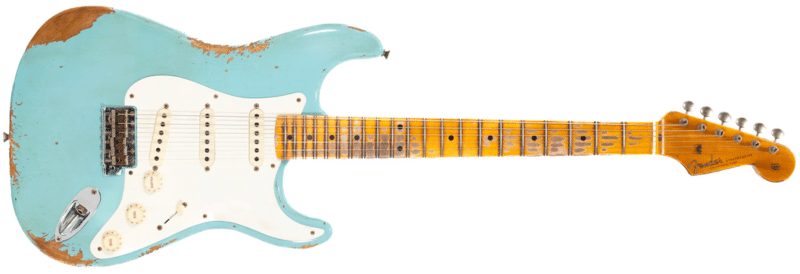
There are several techniques used in the relicing process:
Finish Checking
This involves creating small cracks in the guitar’s finish to mimic the checking that occurs naturally over time. This can be done using various methods, such as applying heat or cold to the guitar’s finish.
Distressing The Body and Neck
This can involve sanding the edges of the guitar body and neck to simulate wear from years of playing. It can also involve intentionally creating dings and scratches on the guitar body.
Hardware Aging
The hardware (pickups, tuning pegs, bridge, etc.) can be artificially aged to give it a tarnished or corroded appearance. This can be done using a variety of methods, such as applying chemicals or using abrasive materials.
Fading The Finish
The guitar’s finish can be faded to simulate the effect of years of exposure to sunlight. This can be done in various ways, such as exposing the guitar to UV light.
It’s important to note that relicing a guitar can potentially decrease its value, particularly if it’s a vintage or high-value instrument. Some players and collectors prefer guitars that have been naturally aged, and artificially aged guitars may not command the same prices.
However, relicing can be a good option for players who want the look of an aged guitar without the wait.
Playing Versus Storing A Guitar

Playing an electric guitar versus storing it can indeed change the way it ages. Here’s how.
Playing The Guitar
Wear And Tear
Regularly playing the guitar can lead to visible signs of wear and tear. This can include scratches and dings on the body from picks and belt buckles, worn spots on the neck and fretboard from hand contact, and fret wear from pressing down the strings. The hardware, such as the tuning machines and bridge, can also show signs of wear from regular use.
Sweat And Oil
The sweat and oils from your hands can affect different parts of the guitar. They can wear down the finish on the neck and body, corrode the strings, and tarnish the hardware.
Tonal Changes
Some guitarists believe that regularly playing a guitar can lead to tonal changes, as the vibrations from the strings can affect the wood over time. However, this is a topic of debate among musicians and luthiers.
Storing The Guitar
Environmental Impact
If a guitar is stored properly in a stable environment, it can age slowly and gracefully. However, if it’s exposed to fluctuating temperatures and humidity levels, it can lead to issues like warping, cracking, and finish checking.
Lack Of Wear
A stored guitar won’t show the same signs of wear and tear as a played guitar. The finish, frets, and hardware can remain in like-new condition for many years.
Component Degradation
Even when stored, certain components of the guitar can degrade over time. For example, the electronic components, such as the pickups and wiring, can deteriorate, potentially affecting the guitar’s sound.
In summary, a played guitar and a stored guitar will age differently, with the played guitar showing more signs of wear and tear and the stored guitar potentially experiencing more environmental impacts. However, both can experience component degradation over time.
Don’t Mess With Vintage Guitars!

The value of a vintage electric guitar is often closely tied to its originality, meaning that all of its parts and finishes are the same as when it left the factory. This is because collectors and enthusiasts often seek out vintage guitars that are as close as possible to their original condition, as these guitars provide a direct link to a specific period in music history.
When original parts are replaced on a vintage guitar, it can significantly decrease the instrument’s value, even if the replacement parts are period-correct or of a higher quality.
It’s also worth noting that certain parts have a greater impact on a vintage guitar’s value than others. Key components like the body, neck, and pickups are particularly important, and replacing these can significantly decrease the guitar’s value. On the other hand, replacing smaller components like the knobs or tuners might have a lesser impact, although it can still decrease the guitar’s value to some extent.
Are You Qualified To Make Guitar Adjustments Or Modifications?
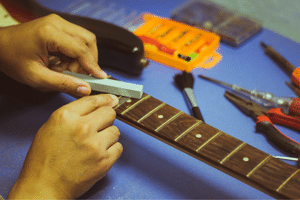
It’s great to work on your guitars, especially if you have a lot of them, but you should always be aware of your limitations.
Adjusting things like an electric guitar’s string height (action) or pickup height can be straightforward. Still, some adjustments require the proper training and experience, like adjusting a guitar’s truss rod.
When you doubt your ability to adjust, repair, or modify your guitar, it’s always best to bring it to a competent guitar technician or luthier (guitar designer & builder). You can permanently damage your guitar, and it might never play and sound right again!
Making modifications to your guitar can void its manufacturer’s warranty and cause permanent damage to the instrument. Certain modifications are irreversible, so you may be stuck with them, even if you desperately want to restore the guitar to its original condition!
I learned that the hard way over the years until I did a three-year apprenticeship in a guitar repair shop. Now I have my own home workshop with the proper training and equipment to safely maintain and repair all my instruments.
Remember: “When In Doubt, Send It Out!”
Famous Aged Electric Guitars
There are numerous examples of famous aged electric guitars that are renowned for their exceptional sound. Here are just a few of the finest examples.
However, it’s important to remember that these are not just any old guitars – they are high-quality instruments played by skilled musicians, and their sound is a product of many factors, not just age.
Blackie

‘Blackie’, the Stratocaster assembled by Eric Clapton from parts of three different 1950s strats. This guitar, used by Clapton for over 15 years, is known for its distinctive, rich tone.
“Blackie” is the nickname Eric Clapton gave to his favorite Fender Stratocaster. In 1970, Clapton switched from Gibson guitars to Fender Stratocasters, mainly due to the influences of Jimi Hendrix and Blind Faith bandmate Steve Winwood. His first Strat, nicknamed “Brownie” for its sunburst brown finish, was used on his albums Eric Clapton and Layla and Other Assorted Love Songs.
Clapton first played Blackie live on January 13, 1973, at the Rainbow Concert. He would play Blackie for many years on and off stage, such as in his guest appearance in The Last Waltz. After the Behind The Sun tour in 1985, it was retired due to issues with the neck.
In 2004, Blackie was sold for 959,500 USD at a Christie’s auction to support the Crossroads Centre, a drug and alcohol addiction rehabilitation center founded by Clapton. The auction’s winner was the music equipment chain Guitar Center, and the bid set the record for the world’s most expensive guitar.
Lucille
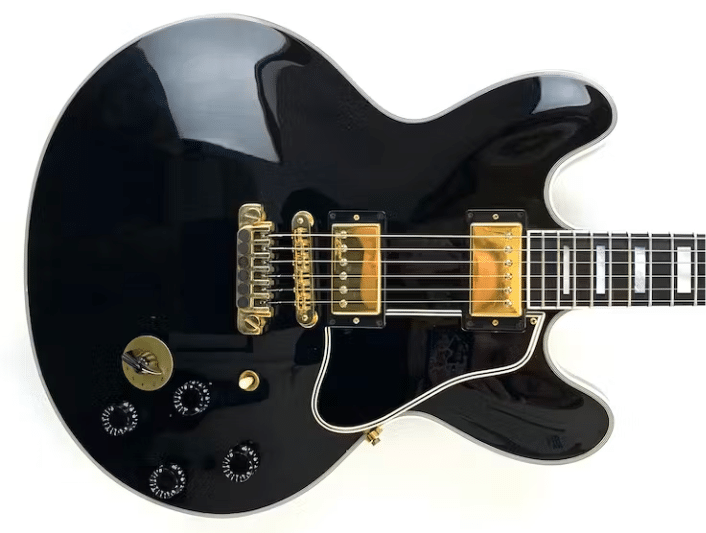
Similarly, ‘Lucille,’ B.B. King’s Gibson ES-355, is another example of an aged guitar with a legendary sound.
“Lucille” is the name the American blues musician B.B. King gave to all his guitars. They were usually black Gibson guitars similar to the ES-330 or ES-355, and Gibson introduced a B.B. King custom model in 1980 based on the latter.
The story of Lucille began in the winter of 1949 when King played at a dance hall in Twist, Arkansas. During a performance, two men began to fight, knocking over a barrel half-filled with burning kerosene and setting the hall on fire.
King ran back into the burning building to retrieve his beloved $30 Gibson guitar. He later found out that the two men had been fighting over a woman named Lucille, who worked at the hall. King decided to name his guitar Lucille as a reminder never to do something as foolish as run into a burning building or fight over a woman.
Greeny
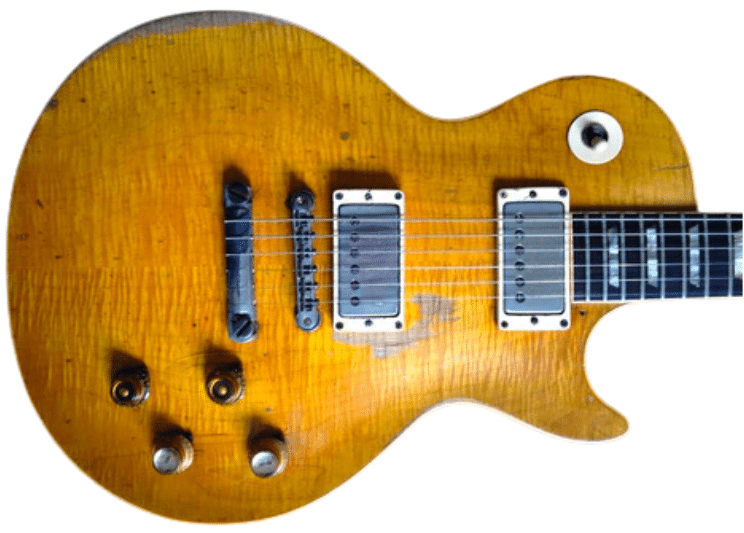
“Greeny” is a 1959 Gibson Les Paul Standard, named after its original owner, Peter Green, who used it during his time in John Mayall & the Bluesbreakers and Fleetwood Mac. The guitar is known for its unique out-of-phase tone, which is the result of a reversed neck pickup. This sound has become highly sought-after amongst guitar players, so much so that flipping the neck pickup has been affectionately referred to as the “Peter Green mod.”
After lending Greeny to Gary Moore for a few days, Green asked if he wanted to buy it. While he owned the guitar, Moore replaced the jack plate as well as the bottom volume and tone knobs. He also replaced the original machine heads with Sperzel tuners.
2006 Moore was forced to sell the guitar due to financial troubles. He sold it to guitar dealer Phil Winfield for somewhere between $750,000 and $1.2 million. It was then put on sale by Winfield for $2 million, after which it was owned by several private collectors.
In 2014 Metallica guitarist Kirk Hammett purchased Greeny from guitar dealer Richard Henry for “less than $2 million.”
The Black Strat

The “Black Strat” is the nickname for a black Fender Stratocaster guitar played by David Gilmour of Pink Floyd. It first appeared with Gilmour at the 1970 Bath Festival and has been featured in many of Pink Floyd’s and Gilmour’s individual albums. It was used in iconic songs like “Money,” “Comfortably Numb,” and “Shine on You Crazy Diamond,” among many others.
Gilmour purchased the guitar, a 1969 model with a maple cap fingerboard and large headstock, in 1970 from Manny’s Music in New York City to replace a similar guitar that had been lost while touring with Pink Floyd in the United States in 1968.
In early 2019 Gilmour announced he would auction many of his guitars for charity, including the Black Strat and the #0001 Strat. On June 20, 2019, it became the most expensive guitar ever sold at that time, selling for a price of US$3,975,000 to guitar collector and Indianapolis Colts owner Jim Irsay.
Modifications Over The Years
The Black Strat was originally a sunburst color but had been repainted black at Manny’s. Since then, it has undergone numerous modifications.
Throughout the 1970s, Gilmour alternated between using necks with maple and rosewood fingerboards on the Stratocaster. He installed an XLR connector to eliminate the hum coming from his Dallas Arbiter Fuzz Face; however, this was quickly removed. He also replaced the original tuners with Kluson tuners.
In 1973, a Gibson PAF Humbucker was installed between the bridge and middle positions of the Strat, but he took out the original single coils and put them in the black pickguard later on. In 1976, the original bridge pickup was replaced by a DiMarzio FS-1. This, in turn, was replaced by a Seymour Duncan SSL-1.
In the 1980s, he replaced the bridge with a Kahler Tremolo System, which was later removed. The installation of the Kahler bridge required a section of wood to be cut out to accommodate the larger unit, which in turn meant a new piece of wood had to be inserted and sprayed black when the old bridge was returned. He also replaced the original tremolo arm with a shortened one.
Key Takeaways

Here are three very important points to remember.
- The aging process can affect various aspects of an electric guitar, from the wood body to the electronic components.
- Some experts believe that aged guitars have a richer, more resonant sound, but this is subjective and depends on individual preferences.
- Proper care and regular servicing are crucial for maintaining a guitar’s sound quality as it ages.
Frequently Asked Questions

Here are some of the questions I get asked about aging guitars.
If your question does not appear here, please put it in the comments, and I will get right back to you with an answer.
What Is The Oldest Electric Guitar Brand?
The oldest electric guitar brand is the Ro-Pat-In Corporation (Electro-Patent-Instrument Company). In 1932, they introduced the “Frying Pan,” a lap steel guitar that is considered the first commercially successful electric guitar. The company later changed its name to Rickenbacker.
At What Age Is A Guitar Considered Vintage?
Technically speaking, there’s no set age, but after about 25 to 30 years a guitar may be considered “vintage.” Each guitar collector may have their own definition, which can vary by guitar make and model.
Do Guitars Get Lighter With Age?
Guitars tend to become lighter as they age. This is because the wood in the guitar dries up over time, causing it to lose moisture and shed some weight. However, this process may take years to occur and may not be noticeable unless you weigh the instrument.
What Is The Lifespan Of An Electric Guitar?
There really isn’t a set age. It depends on the quality of the guitar and how well it’s cared for. Generally speaking, more expensive guitars tend to be better constructed and may last longer.
Can I Make My Electric Guitar Sound Better As It Ages?
Yes, regular maintenance and care can help preserve your electric guitar’s sound quality as it ages. This includes regular cleaning, proper storage in a stable, humidity-controlled environment, and regular servicing to adjust the neck, action, and intonation, and to catch potential issues before they become major problems.
Do All Electric Guitars Improve With Age?
Not necessarily. While some electric guitars may develop a richer or different sound over time, this is not a universal rule. The change in sound depends on many factors, including the quality of the guitar’s materials, how well it’s maintained, and changes in its electronic components.
Final Thoughts

The question “Do Electric Guitars Sound Better With Age?” is one that has sparked much debate among musicians and guitar enthusiasts. While some argue that the aging process can enhance the tone and resonance of an electric guitar, others maintain that the changes are minimal and largely influenced by other factors such as maintenance, usage, and the quality of the original materials.
The truth likely lies somewhere in between, with the aging process potentially offering subtle enhancements to a guitar’s tone but not drastically transforming it.
An electric guitar pickup’s magnets can demagnetize over time, potentially leading to a warmer, mellower tone. This can improve the sound of a Jazz guitar but may diminish the aggressive tone required for a Metal guitar.
The aging of a guitar may be artificially accelerated by “relicing” it, which may or may not enhance its sound.
Ultimately, the best way to ensure a great sound from your electric guitar, whether it’s brand new or has a few years under its belt, is to take good care of it and play it regularly while you enjoy the process of making music.

Here’s a fun little video from Premier Guitar called “Someday you’ll regret that relic job.” check it out!
What To Read Next ➡ Why Are Some Guitars Easier To Play? The Truth Revealed!
Related Article ➡ Guitar Neck Wood Types: The Ultimate Player’s Guide!
Tell Me What You Think

Please leave a comment below if you enjoyed this article, have any questions about aging guitars, or want to give your point of view. I will be happy to help you.
- Do you think the sound of a vintage guitar sounds better than a new one?
- What’s your favorite vintage guitar, and why?
- Would you pay extra money for a custom shop reliced guitar?
- What else is on your mind?



I’ve been playing guitar for years, and let me tell you, the whole vintage vs. new guitar debate has come up so many times in jam sessions with my musician friends. Some of them swear by the sweet, soulful tones of vintage guitars, especially when we’re playing blues or jazz tunes. I’ve even had the chance to try out an old ’60s Strat, and the warmth and character of that thing blew my mind.
But don’t get me wrong, I also love my newer guitars. It’s all about versatility and finding the right tool for the job. In the end, I think it all boils down to personal taste and the music you’re into.
Hi, Miadinh
Thank You for your comments!
I fully agree with you!
As a long-term guitar player, I have a variety of new and vintage guitars. They all sound and play differently, but I can definitely “hear” the character of a vintage Strat or Tele! 😎
Rock On! 🤘
Frank 🎸
Music to my ears. As a fan of the Electric Guitar, this read i would recommend, not only for music lovers or music store owners but also for music classes. This article is well broken down and fully informative. Besides making great sounds, there’s a whole lot to it to make such great sounds. With this article, you could learn the difference between an authentic guitar and an expensive knockoff.
Hi, Brian
Thank You for your comments!
I’m thrilled that you enjoyed the article! 😎
Rock On! 🤘
Frank 🎸